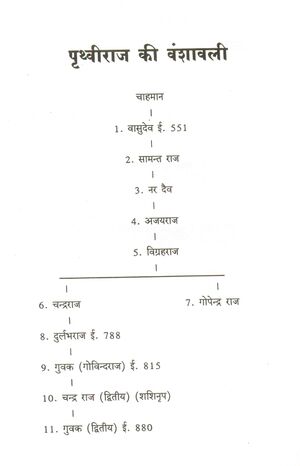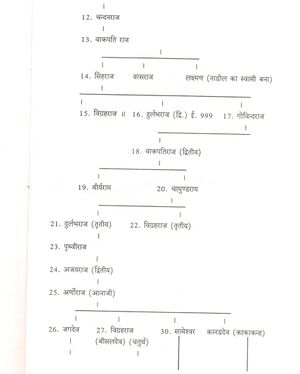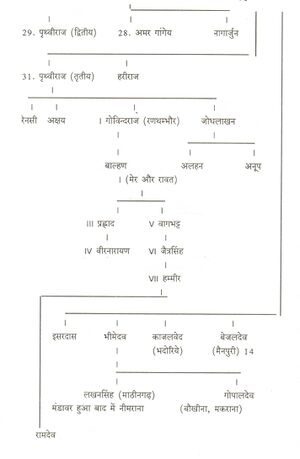Prithvi Raj Chauhan
| Author:Laxman Burdak, IFS (Retd.), Jaipur |
Prithviraj Chauhan (1149–1192 CE), was a king of the Chauhan dynasty, who ruled the kingdoms of Ajmer and Delhi in northern India during the latter half of the 12th century.
Prithviraj Chauhan was the last independent Hindu king, before Hemu, to sit upon the throne of Delhi. He succeeded to the throne in 1169 CE at the age of 20, and ruled from the twin capitals of Ajmer and Delhi which he received from his maternal grandfather, Arkpal or Anangpal III of the Tomara dynasty in Delhi. He controlled much of present-day Rajasthan and Haryana.
Contents
History
Ram Sarup Joon[1] quotes Todd, who writes that the Chauhan King Anhal I, who ruled 39 generations before Prithvi Raj was a Takshak.
इतिहास
पंडित अमीचन्द्र शर्मा[2] ने लिखा है - जिला हिसार में सीसर नामक एक गाँव है। इसमें डबास गोत्री जाटों के बहुत से घर हैं। डबास जाट चौहान संघ से अलग हुये। चौहान संघ मुख्यरूप से जाट गोत्रों का संघ था। पृथ्वीराज चौहान की एक रानी पूनिया गोत्र की थी। पूनिया गोत्र की रानी से 2 पुत्र हुये 1. डबास 2. दहिया डबास से डबास जाट गोत्र शुरू हुआ और दहिया से दहिया गोत्र। यह विवरण सीसर के चौधरी फतेह सिंह ने लिखवाया।
नोट- लेखक पंडित अमीचन्द्र शर्मा ने अन्य गोत्रों में लिखा है कि अमुख राजपूत ने जाटनी से शादी करली इसलिए वह जाट हो गया और उससे अमुख जाट गोत्र निकला तो यहाँ पृथ्वीराज चौहान ने पूनीया जाट रानी से शादी की थी तो वह भी जाट ही कहलाना चाहिए? [3]
चौहान सम्राट
संत श्री कान्हाराम[4] ने लिखा है कि.... [पृष्ठ-76]: ईसा की दसवीं सदी में प्रतिहारों के कमजोर पड़ने पर प्राचीन क्षत्रिय नागवंश की चौहान शाखा शक्तिशाली बनकर उभरी। अहिच्छत्रपुर (नागौर) तथा शाकंभरी (सांभर) चौहनों के मुख्य स्थान थे। चौहनों ने 200 वर्ष तक अरबों, तुर्कों, गौरी, गजनवी को भारत में नहीं घुसने दिया।
चौहनों की ददरेवा (चुरू) शाखा के शासक जीवराज चौहान के पुत्र गोगा ने नवीं सदी के अंत में महमूद गजनवी की फौजों के छक्के छुड़ा दिये थे। गोगा का युद्ध कौशल देखकर महमूद गजनवी के मुंह से सहसा निकल पड़ा कि यह तो जाहरपीर (अचानक गायब और प्रकट होने वाला) है। महमूद गजनवी की फौजें समाप्त हुई और उसको उल्टे पैर लौटना पड़ा। दुर्भाग्यवश गोगा का बलिदान हो गया। गोगाजी के बलिदान दिवस भाद्रपद कृष्ण पक्ष की गोगा नवमी को भारत के घर-घर में लोकदेवता गोगाजी की पूजा की जाती है और गाँव-गाँव में मेले भरते हैं।
[पृष्ठ-77]: चौथी पाँचवीं शताब्दी के आस-पास अनंत गौचर (उत्तर पश्चिम राजस्थान, पंजाब, कश्मीर तक) में प्राचीन नागवंशी क्षत्रिय अनंतनाग का शासन था। इसी नागवंशी के वंशज चौहान कहलाए। अहिछत्रपुर (नागौर) इनकी राजधानी थी। आज जहां नागौर का किला है वहाँ इन्हीं नागों द्वारा सर्वप्रथम चौथी सदी में धूलकोट के रूप में दुर्ग का निर्माण किया गया था। इसका नाम रखा नागदुर्ग। नागदुर्ग ही बाद में अपभ्रंश होकर नागौर कहलाया।
551 ई. के आस-पास वासुदेव नाग यहाँ का शासक था। इस वंश का उदीयमान शासक सातवीं शताब्दी में नरदेव हुआ। यह नागवंशी शासक मूलतः शिव भक्त थे। आठवीं शताब्दी में ये चौहान कहलाए। नरदेव के बाद विग्रहराज द्वितीय ने 997 ई. में मुस्लिम आक्रमणकारी सुबुक्तगीन को को धूल चटाई। बाद में दुर्लभराज तृतीय उसके बाद विग्रहराज तृतीय तथा बाद में पृथ्वीराज प्रथम हुये। इन्हीं शासकों को चौहान जत्थे का नेतृत्व मिला। इस समय ये प्रतिहरों के सहायक थे। 738 ई. में इनहोने प्रतिहरों के साथ मिलकर राजस्थान की लड़ाई लड़ी थी।
नागदुर्ग के पुनः नव-निर्माण का श्री गणेश गोविन्दराज या गोविन्ददेव तृतीय के समय (1053 ई. ) अक्षय तृतीय को किया गया। गोविंद देव तृतीय के समय अरबों–तुर्कों द्वारा दखल देने के कारण चौहनों ने अपनी राजधानी अहिछत्रपुर से हटकर शाकंभरी (सांभर) को बनाया। बाद में और भी अधिक सुरक्षित स्थान अजमेर को अजमेर (अजयपाल) ने 1123 ई. में अपनी राजधानी बनाया। यह नगर नाग पहाड़ की पहाड़ियों के बीच बसाया था। एक काफी ऊंची पहाड़ी पर “अजमेर दुर्ग” का निर्माण करवाया था। अब यह दुर्ग “तारागढ़” के नाम से प्रसिद्ध है।
अजमेर से डिवेर के के बीच के पहाड़ी क्षेत्र में प्राचीन मेर जाति का मूल स्थान रहा है। यह मेरवाड़ा कहलाता था। अब यह अजमेर – मेरवाड़ा कहलाता है। अजयपाल ने अपने नाम अजय शब्द के साथ मेर जाति से मेर लेकर अजय+मेर = अजमेर रखा। अजमेर का नाम अजयमेरु से बना होने की बात मनगढ़ंत है। अजयपाल ने मुसलमानों से नागौर पुनः छीन लिया था। बाद में अपने पुत्र अर्नोराज (1133-1153 ई.) को शासन सौंप कर सन्यासी बन गए। अजयपाल बाबा के नाम से आज भी मूर्ति पुष्कर घाटी में स्थापित है। अरनौराज ने पुष्कर को लूटने वाले मुस्लिम आक्रमणकारियों को हराने के उपलक्ष में आना-सागर झील का निर्माण करवाया।
[पृष्ठ-78]: विग्रहराज चतुर्थ (बिसलदेव) (1153-1164 ई) इस वंश का अत्यंत पराक्रमी शासक हुआ। दिल्ली के लौह स्तम्भ पर लेख है कि उन्होने म्लेच्छों को भगाकर भारत भूमि को पुनः आर्यभूमि बनाया था। बीसलदेव ने बीसलपुर झील और सरस्वती कथंभरण संस्कृत पाठशाला का निर्माण करवाया जिसे बाद में मुस्लिम शासकों ने तोड़कर ढाई दिन का झौंपड़ा बना दिया। इनके स्तंभों पर आज भी संस्कृत श्लोक उत्कीर्ण हैं। जगदेव, पृथ्वीराज द्वितीय, सोमेश्वर चौहानों के अगले शासक हुये। सोमेश्वर का पुत्र पृथ्वीराज तृतीय (1176-1192 ई) ही पृथ्वीराज चौहान के नाम से विख्यात हुआ। यह अजमेर के साथ दिल्ली का भी शासक बना।
Madanpur Inscriptions of Prithviraja III year V. 1239 (1182 AD)
There is one Inscripton incised on a Jaina temple which shows that Prithviraja III conquered Chandel ruler Parmardi or Paramala.
Jinapala's Kharataragachchhapaṭṭavalī tells us that in V. 1239 (1182 AD) Prithviraja III started his digvijaya and on his conquest of all quarters had pitched his first camp at Narayana. He marched against Jejakabhukti, which according to Madanpur (Bundelkhand) Inscriptions, "was laid waste in V.1239 by Prithviraja III, the son of Someshvara and the grandson of Arnoraja".
Prithviraja III conquered Mahoba, the capital of Chandel ruler Parmardi or Paramala, after a stiff fight with Banafara hroes Alha and Udala who were aided also by an army of Kanauj. [5]
The original text is as under:
- श्री चाहुमान-वंश्येन पृथ्वीराजेन भूभुजा |
- परमर्दी-नरेन्द्रस्य देशोयमुदवास्यत ||
- अर्णोराजस्य पौत्रेण श्रीसोमेश्वरसुनुना |
- जैजाकभुक्तिदेशोयं पृथ्वीराजेन लूनित: ||
- संवत् 1239
Reference - Dasharatha Sharma, Early Chauhan Dynasties", pp.109.
First Battle of Tarain 1191
In 1191, Shahabuddin Muhammad Ghori captured the fortress of Bhatinda in East Punjab, leaving a garrison of 1200 men, which was located on the frontier of Prithiviraj Chauhan's domains. Prithviraj marched to Bhatinda and met his enemy at a place called Tarain (also called Taraori) near the ancient town of Thanesar. The Ghurid army initiated battle by attacking with cavalry who launch arrows at the Prithviraja's army. The forces of Prithviraj counter-attacked from three sides and dominated the battle, pressuring the Ghurid army into a withdrawal. Meanwhile, Mu'izz al-Din was wounded in personal combat with Prithviraj's brother, Govind Tai.[2] Prithviraj succeeded in stopping the Ghurid advance towards Hindustan in the first battle of Tarain. He did not pursue Ghori's army either not wanting to invade hostile territory or misjudging Ghori's ambition,[3] instead electing to retake the fortress of Bhatinda.[6]
Second Battle of Tarain 1192
In 1192, Ghori reassembled an army of 120,000 men and returned to challenge Chauhan at the Second Battle of Tarain. When he reached Lahore, he sent his envoy to demand surrender but Chauhan refused to comply. Chauhan then appealed to his fellow rulers and the aristocracy to come to his aid against Ghori.[7]
Chauhan assembled a very large army with the aid of approximately 150 rulers and aristocrats. According to the Persian historian Firishta, it consisted of 3,000 elephants, 300,000 horsemen, and considerable infantry. The army was larger than that of Ghori. The armies met in Tarain, where Ghori delivered an ultimatum to Chauhan that he convert to Islam or be defeated. Chauhan countered with an offer that Ghori should consider a truce and be allowed to retreat with his army. Ghori decided to attack.[8]
Ghori divided his troops into five parts and attacked in the early morning hours, sending waves of mounted archers. They retreated as the Chauhan elephant phalanx advanced. Ghori deployed four parts to attack the Chauhans on four sides, keeping a fifth part of his army in reserve. General Khande Rao of the Chauhan forces was killed. At dusk, Ghori himself led a force of 12,000 heavily armored horsemen to the centre of the Chauhan line, which collapsed into confusion. Chauhan attempted to escape but was captured. The Chauhan army broke ranks and fled, thereby conceding victory to Ghori.[9] Chauhan was put to death.[10]
Further reading
See article Prithviraj Chauhan and his times
Jat connections
- Prithvi Raj's commander-in-chief was Chand Ram, Dahima Jat.
- Kaimas Dahiya or Kaimas or Kaimas Dahima was chief minister of Prithviraj Chauhan during his childhood.
- Nihal Singh Arya [11] writes that Joga Ram Dahiya was the Commander of Ajaypal Chauhan, the founder of Ajmer. Vigrharaja Bisaldev, 5-6 generations ancestor of Prithviraj Chauhan founded the Ajmer Fort when Daburam Dahiya formed a separate group. Daburam Dahiya is the ancestor of Dabuwas or Dabas Khap formed at Kanjhawala (Delhi).
External links
References
- ↑ Ram Sarup Joon: History of the Jats/ChapterVIII,p. 136
- ↑ Jat Varna Mimansa (1910) by Pandit Amichandra Sharma, p.39
- ↑ Laxman Burdak (talk) 03:37, 19 July 2017 (EDT)
- ↑ Sant Kanha Ram: Shri Veer Tejaji Ka Itihas Evam Jiwan Charitra (Shodh Granth), Published by Veer Tejaji Shodh Sansthan Sursura, Ajmer, 2015. pp.76-78
- ↑ "Early Chauhan Dynasties" by Dasharatha Sharma, pp. 83
- ↑ A Global Chronology of Conflict: From the Ancient World to the Modern Middle East, Vol. I, (ABC-CLIO, 2010), 263.
- ↑ Satish Chandra, Medieval India: From Sultanat to the Mughals (1206-1526), Part 1, (Har-Anand Publications, 2006), 25.
- ↑ Satish Chandra, Medieval India: From Sultanat to the Mughals (1206-1526), Part 1, (Har-Anand Publications, 2006), 25.
- ↑ Satish Chandra, Medieval India: From Sultanat to the Mughals (1206-1526), Part 1, (Har-Anand Publications, 2006), 25.
- ↑ Barua, Pradeep (2005). The State at War in South Asia. University of Nebraska Press. p. 29. ISBN 9780803213449.
- ↑ Prithviraj Chauhan and his times, 1980, pp. 102-107


